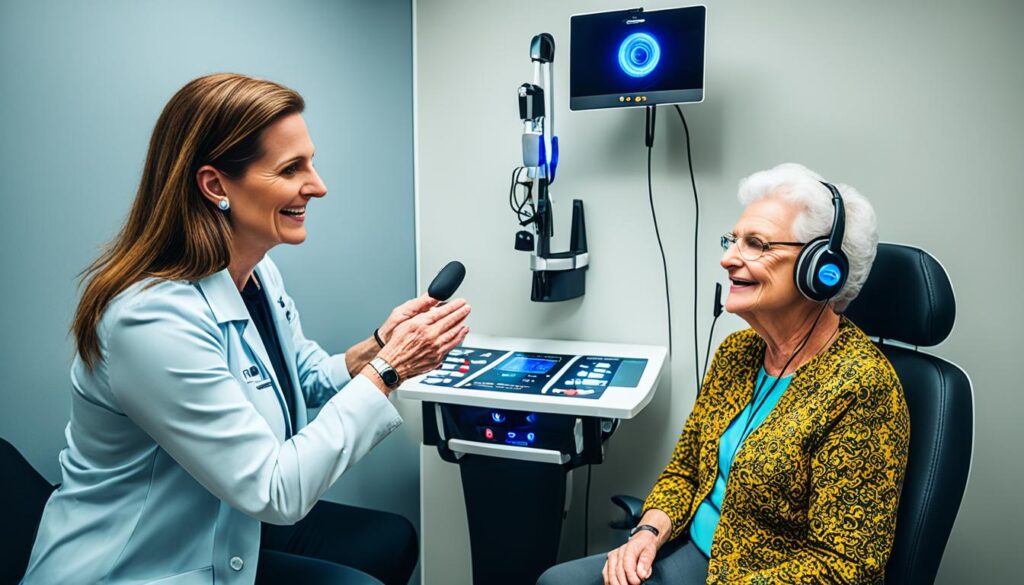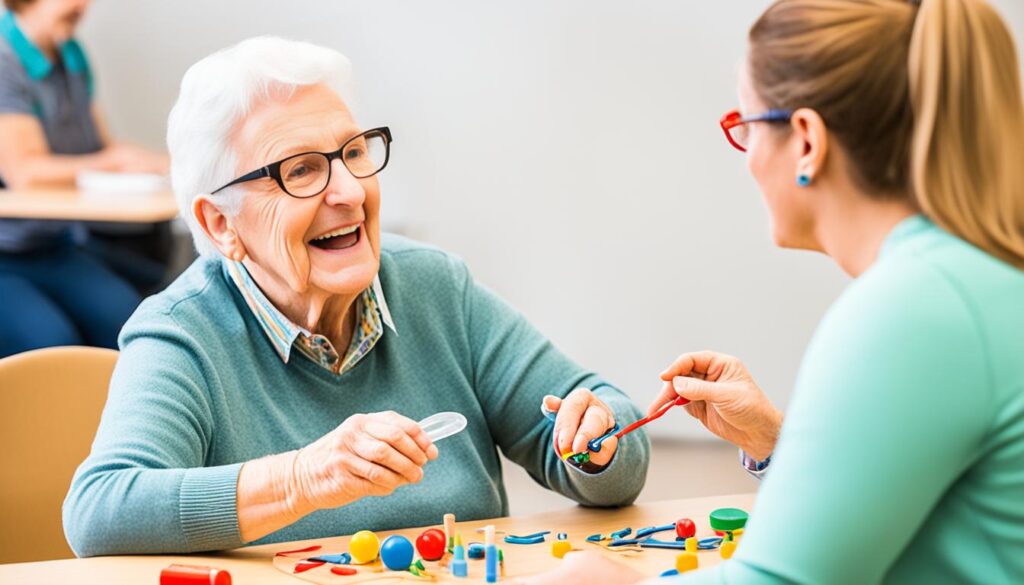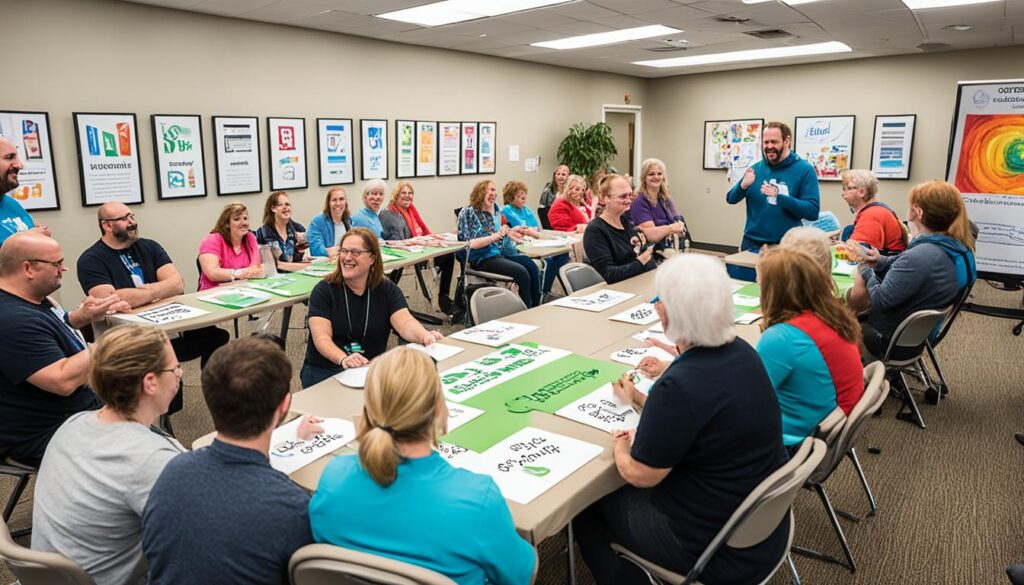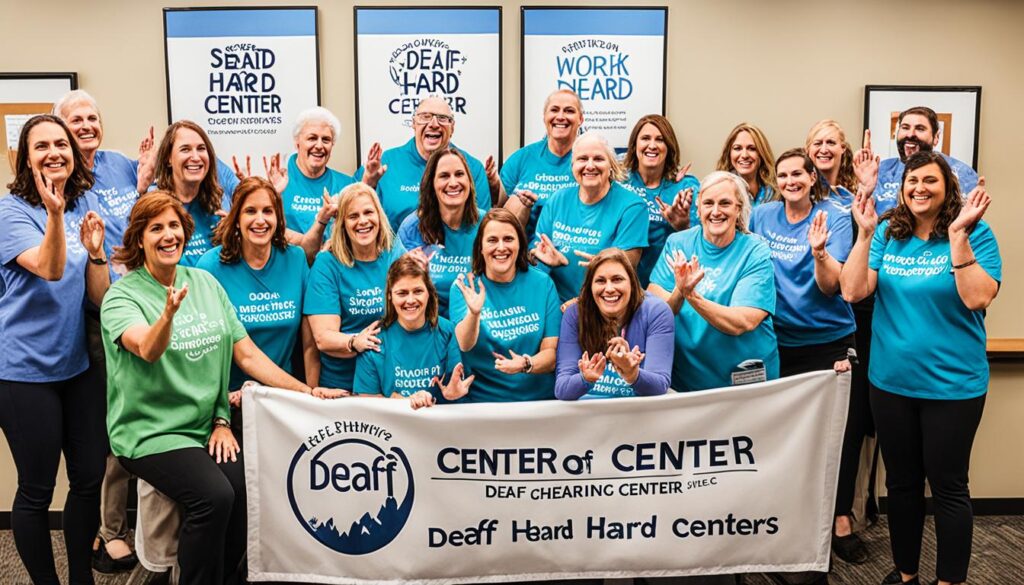The Deaf and Hard of Hearing Center is like a superhero team for folks who find it tough to hear. They’re all about giving a helping hand and tools to make chatting and listening as smooth as pie. Imagine having a buddy who knows all about making sounds clearer, teaching sign language, and even setting up fun get-togethers so you never feel left out. In one year, 2022, they lit up the lives of over 3400 people, handed out more than 7000 hours of sign language help, and fitted over 1200 ears with gadgets that bring sounds to life. If sounds sometimes feel like they’re playing hide and seek with you, this place is your treasure map to finding them. Why keep reading? Because you might just discover some magic for your ears!
Key Takeaways:
- The Comprehensive Deaf and Hard of Hearing Center offers a comprehensive range of services for individuals with hearing loss.
- Services include audiology, speech therapy, occupational therapy, ASL interpretation, and community events.
- In 2022, the center served over 3400 individuals, provided over 7000 hours of ASL interpreting, and dispensed over 1200 hearing aids and assistive listening devices.
- Supporting the center helps empower individuals with hearing loss and promotes inclusivity in the deaf and hard of hearing community.
- Advocacy and consultation services ensure equal access and effective communication for individuals with hearing loss in various areas of life.
Audiological Services
The Deaf and Hard of Hearing Center offers comprehensive audiological services to individuals with hearing loss. Their expert team of audiologists is dedicated to providing personalized care and support to their clients throughout their hearing journey.
At the center, individuals can avail themselves of various audiological services, including:
- Hearing assessments: Through thorough and accurate diagnostic testing, the audiologists assess the nature and severity of hearing loss, enabling them to develop personalized treatment plans.
- Hearing aid fittings: The center offers professional hearing aid fittings to ensure optimal comfort and performance. They take into account individual preferences and lifestyle needs to select the most suitable hearing aids.
- Assistive listening device recommendations: In addition to hearing aids, the center provides recommendations for assistive listening devices that can further enhance communication and accessibility in different environments.
With their vast experience and understanding of the challenges faced by individuals with hearing loss, the Deaf and Hard of Hearing Center is committed to improving communication and quality of life for their clients. In 2022 alone, they dispensed over 1200 hearing aids and assistive listening devices, effectively transforming the lives of numerous individuals.
Whether it’s a comprehensive hearing assessment, a customized hearing aid fitting, or recommendations for assistive listening devices, the audiological services at the Deaf and Hard of Hearing Center are designed to meet the unique needs of each individual and empower them to participate fully in their personal and professional lives.

Note: The image above depicts an audiologist using audiology equipment in a professional setting.
Speech Therapy
The Comprehensive Deaf and Hard of Hearing Center offers speech therapy services to individuals of all ages, providing them with the necessary support to improve their verbal communication skills. Our experienced speech therapists understand the unique challenges faced by individuals with hearing loss and tailor treatment plans to address their specific needs.
Through speech therapy, our goal is to empower patients and help them express themselves more effectively. We focus on enhancing their speech and language abilities, allowing them to communicate with confidence and clarity in various settings.
Our speech therapists utilize evidence-based techniques and specialized tools to facilitate speech development and improve overall communication skills. We work closely with each patient to set individualized goals and track progress along the way.
Whether it’s developing clearer speech sounds, improving fluency, or enhancing expressive language skills, our speech therapy services provide comprehensive support in overcoming communication barriers. We also offer assistance in augmentative and alternative communication (AAC) methods for those who may benefit from additional communication tools.
At the Comprehensive Deaf and Hard of Hearing Center, we believe that effective communication is essential for individuals to thrive and fully participate in their personal, academic, and professional lives. By offering speech therapy services tailored to the specific needs of individuals with hearing loss, we aim to provide them with the necessary skills and confidence to communicate with ease.
| Benefits of Speech Therapy at our Center |
|---|
| Improved speech clarity and articulation |
| Enhanced expressive language skills |
| Greater confidence in communication |
| Improved social interaction and relationships |
| Development of effective communication strategies |

Occupational Therapy
Occupational therapy plays a crucial role in the comprehensive services offered at the Deaf and Hard of Hearing Center. Our dedicated occupational therapists work closely with individuals to improve their motor skills and address sensory processing disorders. Through personalized interventions and therapeutic techniques, occupational therapy enhances their ability to participate in daily activities and fully engage in their world.
Children and adults with hearing loss may face additional challenges in sensory and motor development. Occupational therapy provides them with the support and tools they need to overcome these obstacles. By focusing on improving motor skills and addressing sensory processing disorders, occupational therapists empower individuals to build a strong foundation for independent living and achieve optimal functioning.
Our occupational therapy programs are tailored to meet the unique needs of each individual. Whether it’s developing fine motor skills, enhancing hand-eye coordination, or improving sensory integration, our therapists provide expert guidance and personalized strategies. Through a holistic approach, they help individuals achieve their goals and maximize their potential.
The Benefits of Occupational Therapy
Occupational therapy offers a range of benefits for individuals with hearing loss:
- Improved Motor Skills: Occupational therapy targets motor skills development, including fine and gross motor skills, coordination, and balance. These improvements support individuals in performing daily activities with confidence and ease.
- Treatment of Sensory Processing Disorders: Sensory processing disorders can significantly impact a person’s ability to process and respond to sensory information. Occupational therapy addresses these challenges, helping individuals regulate their sensory experiences and enhance their overall well-being.
- Enhanced Independence and Participation: By strengthening essential skills, such as self-care, feeding, and dressing, occupational therapy promotes independence and active participation in personal, social, and academic contexts.
- Promotion of Overall Development: Occupational therapy supports holistic development, focusing not only on motor skills but also on cognitive, sensory, and social-emotional growth.
Occupational therapy is a valuable and integral part of our commitment to providing comprehensive support for individuals with hearing loss. Through evidence-based interventions and individualized care, our occupational therapists empower individuals to thrive and lead fulfilling lives.

| Occupational Therapy Services | Benefits |
|---|---|
| Motor skills development | Improved ability to perform daily activities |
| Sensory processing disorder treatment | Enhanced sensory regulation and well-being |
| Personalized interventions | Targeted support for individual needs |
| Independence and participation | Promotes active engagement in daily life |
American Sign Language (ASL) Interpretation
The Deaf and Hard of Hearing Center is committed to providing comprehensive communication access for the deaf community through American Sign Language (ASL) interpretation services. Our highly skilled ASL interpreters facilitate effective communication in various settings, ensuring that individuals who use sign language as their primary mode of communication can fully participate and engage.
ASL interpretation plays a crucial role in promoting inclusivity and equal access to information. By bridging the gap between sign language users and speakers of spoken languages, ASL interpreters facilitate meaningful communication and enhance understanding between individuals with different linguistic backgrounds.
Whether it’s at medical appointments, educational institutions, job interviews, business meetings, or community events, our ASL interpreters are here to ensure that communication barriers are eliminated, fostering a more inclusive and accessible environment for all.
High-Quality ASL Interpretation Services
At the Deaf and Hard of Hearing Center, we understand the importance of providing accurate and culturally sensitive ASL interpretation. Our team of certified ASL interpreters has extensive experience and expertise in a wide range of fields, ensuring that communication is conveyed accurately, effectively, and confidentially.
With our commitment to professionalism and continuous education, our interpreters stay up-to-date with the latest industry standards and practices, ensuring that our clients receive the highest quality interpretation services.
Whether it’s a one-on-one conversation or a large-scale event, our ASL interpreters adapt to various communication settings, including medical, legal, education, vocational rehabilitation, and entertainment. They are skilled at interpreting spoken language into ASL and vice versa, enabling effective communication and facilitating meaningful interactions.
Empowering individuals with hearing loss to fully participate in their personal and professional lives is at the core of our ASL interpretation services. We strive to ensure that every communication need is met, fostering inclusivity and equal access to information for the deaf and hard of hearing community.
| Benefits of Our ASL Interpretation Services |
|---|
| Effective communication and understanding between sign language users and speakers of spoken languages |
| Fostering inclusivity and equal access to information in various settings |
| Facilitating participation in medical appointments, educational institutions, job interviews, business meetings, and community events |
| Certified ASL interpreters with expertise in various fields |
| Adaptable to different communication settings and contexts |
| Promoting accurate and culturally sensitive interpretation |

By providing ASL interpretation services, the Deaf and Hard of Hearing Center is committed to breaking down communication barriers and ensuring that individuals with hearing loss have equal access to information and opportunities. Our ASL interpreters are passionate about facilitating effective communication, empowering individuals, and creating a more inclusive society for all.
Community Events
The Comprehensive Deaf and Hard of Hearing Center understands the importance of fostering a sense of community among individuals with hearing loss. That’s why we organize and host a variety of community events specifically designed for the deaf community. These events offer unique opportunities for socializing, networking, and building meaningful connections with others who share similar experiences.
Our community events go beyond just providing entertainment; they are a platform for individuals with hearing loss to come together, celebrate their culture, and forge lasting friendships. We believe that creating a strong support network is essential for the well-being and empowerment of the deaf community.
During our community events, attendees can participate in a range of activities, including workshops, performances, art exhibitions, sports events, and social gatherings. These events not only promote inclusivity but also provide a safe and supportive space for individuals to express themselves and fully engage with their community.
Our upcoming community events include:
- Deaf Cultural Festival: A celebration of deaf culture through art, music, and performances.
- ASL Poetry Night: An opportunity for poets and enthusiasts to showcase their talent in American Sign Language.
- Deaf Awareness Walkathon: A fundraising event to raise awareness about hearing loss and support our programs and services.
- Job Fair: Connect with employers who are committed to creating inclusive workplaces for individuals with hearing loss.
We believe that these community events play a crucial role in breaking barriers, cultivating a sense of belonging, and empowering individuals with hearing loss. By nurturing a vibrant deaf community, we aim to create a world where everyone can thrive regardless of their hearing abilities.

Join us at our upcoming community events and be part of the deaf community’s journey towards inclusivity and empowerment!
Support Our Work
The Comprehensive Deaf and Hard of Hearing Center relies on the support of the community to continue providing its vital services. As a nonprofit organization, we depend on generous donations to fund our programs and initiatives. Your contribution can make a significant impact and help us empower individuals with hearing loss.
There are several ways you can support our work:
1. Donate to our Vision 100 Endowment Campaign
By donating to our Vision 100 Endowment Campaign, you can help us secure the long-term sustainability of our programs. Your contribution will be invested in our endowment fund, generating income that will support our mission for years to come. Help us create a lasting impact in the lives of individuals with hearing loss.
2. Make a General Donation
If you prefer to make a general donation, your contribution will go directly towards supporting our programs and services. Every donation, no matter the amount, enables us to provide audiology services, speech therapy, occupational therapy, ASL interpretation, and community events that benefit the deaf and hard of hearing community.

3. Volunteer Your Time
We also welcome volunteers who are passionate about our mission. If you have the skills and expertise to share, consider joining our team of volunteers. You can make a difference by assisting with events, providing support to individuals with hearing loss, or helping us raise awareness in the community.
Support from individuals like you is crucial in enabling us to continue providing the highest quality services and support to those who need it most. Together, we can create a more inclusive and accessible world for individuals with hearing loss.
Educational Services
The Comprehensive Deaf and Hard of Hearing Center is committed to providing individuals identified as deaf or hard of hearing with comprehensive educational services. Our range of programs is designed to meet the unique academic and communication needs of students at different stages of their educational journey.
Early Intervention Programs
Our early intervention programs are tailored to support young children with hearing loss in their developmental journey. Through specialized instruction and resources, we empower children to build strong foundations for language acquisition, communication, and school readiness.
Itinerant Services
For older students who are integrated into mainstream schools, our itinerant services provide vital support. Our team works closely with schools and educators to ensure that deaf and hard of hearing students have access to the educational tools and accommodations they need to thrive academically.
Designated School Sites
In addition to itinerant services, we also offer designated school sites where students can receive specialized education within a supportive environment that understands their unique needs. These sites provide a comprehensive curriculum that incorporates individualized instruction, assistive technologies, and access to qualified educators with expertise in deaf education.
Empowering Academic Success
Our educational services aim to promote equal access to education for individuals with hearing loss. By providing specialized support, we strive to empower students to achieve academic success and unlock their full potential. We believe that every individual deserves the opportunity to thrive in an inclusive learning environment.
| Program | Highlights |
|---|---|
| Early Intervention Programs | Supporting language acquisition and school readiness in young children with hearing loss. |
| Itinerant Services | Collaborating with mainstream schools to provide support and accommodations for deaf and hard of hearing students. |
| Designated School Sites | Offering specialized educational environments for students with hearing loss, incorporating individualized instruction and assistive technologies. |
Through our educational services, we are committed to equipping individuals with the skills they need to succeed academically and in life. We believe that education is a fundamental right, and we strive to create inclusive learning environments that empower individuals with hearing loss to thrive.

Advocacy and Consultation
The Deaf and Hard of Hearing Center understands the importance of advocacy and consultation in helping individuals with hearing loss achieve equal access and effective communication in all aspects of their lives. Through their dedicated advocacy services, they work tirelessly to protect the rights of the deaf and hard of hearing community, ensuring that they are heard and valued.
The center collaborates with individuals, families, and organizations to create a more inclusive society for those with hearing loss. By raising awareness and promoting change, they strive to eliminate barriers and discrimination that may hinder the full participation of individuals with hearing loss in employment, transportation, recreation, public accommodations, and telecommunication services.
Through their consultation services, the Deaf and Hard of Hearing Center provides expert guidance and support to individuals seeking equal access and effective communication. Whether it’s navigating workplace accommodations, understanding legal rights, or advocating for accessible communication services, their team of professionals is available to provide valuable insights and strategies.
By working closely with individuals and organizations, the center ensures that appropriate accommodations and services are implemented, allowing individuals with hearing loss to thrive and contribute fully to their communities.
Advocacy Services
The Deaf and Hard of Hearing Center offers a range of advocacy services aimed at protecting the rights of individuals with hearing loss. These services include:
- Individual advocacy, where they provide personalized support and guidance in navigating various systems and processes.
- Policy advocacy, where they work to influence legislative and policy changes that will benefit the deaf and hard of hearing community.
- Community advocacy, where they collaborate with community organizations and stakeholders to promote inclusivity and accessibility.
Consultation Services
The consultation services provided by the Deaf and Hard of Hearing Center are designed to offer expert advice and guidance on a range of topics related to equal access and effective communication. These services include:
- Workplace consultation, where they assist employers and employees in implementing appropriate accommodations to create a more inclusive work environment.
- Legal consultation, where they provide guidance on legal rights and protections for individuals with hearing loss.
- Communication consultation, where they offer strategies and recommendations for effective communication in various settings.
The Deaf and Hard of Hearing Center’s advocacy and consultation services play a crucial role in promoting equal access and empowering individuals with hearing loss to live life to the fullest. Through their dedicated efforts, they continue to break down barriers and create a more inclusive society for all.
| Advocacy and Consultation Services | Benefits |
|---|---|
| Individual advocacy | Personalized support and guidance in navigating systems and processes |
| Policy advocacy | Influence legislative and policy changes for the benefit of the deaf and hard of hearing community |
| Community advocacy | Collaborate with community organizations to promote inclusivity and accessibility |
| Workplace consultation | Assist employers and employees in implementing appropriate accommodations for a more inclusive work environment |
| Legal consultation | Guidance on legal rights and protections for individuals with hearing loss |
| Communication consultation | Recommendations for effective communication strategies in various settings |
Advocacy and consultation services are essential for ensuring equal access and empowering individuals with hearing loss to fully participate in all aspects of life. With the support of the Deaf and Hard of Hearing Center, positive change can be achieved, creating a more inclusive and accessible society for everyone.

Communication Support
The Comprehensive Deaf and Hard of Hearing Center understands the importance of effective communication for individuals with hearing loss. They provide a range of communication support services to enhance access and inclusivity.
One of the key services offered is assistive listening devices. These devices improve communication by amplifying sound and reducing background noise. From hearing aids to personal FM systems, the center recommends and provides assistive listening devices tailored to each individual’s needs.

In addition to assistive listening devices, the center recognizes the significance of sign language interpretation in facilitating effective communication. They offer professional sign language interpreters for various situations, including medical visits, job interviews, training sessions, and education classes. Sign language interpreters bridge the communication gap between people who use sign language and those who do not, empowering individuals with hearing loss to fully participate and engage in different settings.
The center also provides consultations to ensure optimal communication in specific situations. Whether it’s preparing for a medical appointment or an important job interview, their communication support team offers guidance and strategies to facilitate clear and meaningful communication between individuals with hearing loss and others.
By offering a comprehensive range of communication support services, the center aims to break down barriers and foster effective communication for individuals with hearing loss.
| Communication Support Services | Description |
|---|---|
| Assistive Listening Devices | Devices that amplify sound and reduce background noise |
| Sign Language Interpreters | Professional interpreters for sign language communication |
| Consultations | Guidance and strategies for clear communication in specific situations |
Conclusion
The Comprehensive Deaf and Hard of Hearing Center is a vital resource for individuals with hearing loss. With a wide range of services, including audiology, speech therapy, occupational therapy, ASL interpretation, and community events, the center is dedicated to supporting individuals in reaching their full communication potential.
Through audiological services, the center provides comprehensive assessments, hearing aid fittings, and assistive listening device recommendations, improving communication and enhancing the quality of life for their clients. Speech therapy services are tailored to address the unique communication needs of individuals of all ages, empowering them to express themselves more effectively.
Occupational therapy helps individuals with hearing loss improve their motor skills and treat sensory processing disorders, allowing them to fully participate in daily activities. ASL interpretation ensures that individuals who use sign language as their primary mode of communication have equal access to information, fostering inclusivity.
The center also organizes community events that create opportunities for socializing, networking, and building strong support networks within the deaf community. These events contribute to a sense of belonging and foster a supportive environment for individuals with hearing loss.
By supporting the Comprehensive Deaf and Hard of Hearing Center, individuals can contribute to the empowerment and well-being of the deaf and hard of hearing community, ensuring that everyone has access to hearing loss support and community events. Together, we can create a more inclusive society.
FAQ
What services does the Comprehensive Deaf and Hard of Hearing Center offer?
The center offers audiology and hearing loss support, speech therapy, occupational therapy, American Sign Language interpretation, community events, educational services, advocacy and consultation, and communication support.
What audiological services are available at the center?
The center provides hearing assessments, hearing aid fittings, and recommendations for assistive listening devices to improve communication and quality of life for individuals with hearing loss.
How can speech therapy help individuals with hearing loss?
Speech therapy services are available to help individuals improve their verbal communication skills. Therapists work with patients to develop customized treatment plans and enhance their ability to express themselves effectively.
What does occupational therapy involve at the Deaf and Hard of Hearing Center?
Occupational therapy focuses on improving motor skills and treating sensory processing disorders. Therapists work with individuals to enhance their ability to engage in daily activities and navigate their world more effectively.
Do they provide American Sign Language interpretation services?
Yes, the center provides ASL interpreters for various settings to ensure communication access for individuals who use sign language as their primary mode of communication.
Does the center host community events for the deaf community?
Yes, the center organizes and hosts a variety of events specifically for the deaf community. These events provide opportunities for socializing, networking, and fostering a sense of belonging.
How can I support the work of the Deaf and Hard of Hearing Center?
You can support the center by contributing to their Vision 100 Endowment Campaign or making general donations to help empower individuals with hearing loss.
What educational services are available for individuals with hearing loss?
The center offers a full range of educational services, including early intervention programs for young children and designated school sites for older students, to ensure equal access to education and support academic success.
What advocacy and consultation services does the center provide?
The center offers advocacy and consultation services to help individuals with hearing loss achieve equal access and effective communication in various areas of their lives, including employment, transportation, recreation, public accommodations, and telecommunication services.
What communication support services are available at the center?
The center provides communication support services, including assistive listening devices, sign language interpreters, and other communication tools. They also offer consultations for medical visits, job interviews, training and education classes, and other situations where effective communication is essential.











